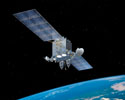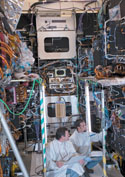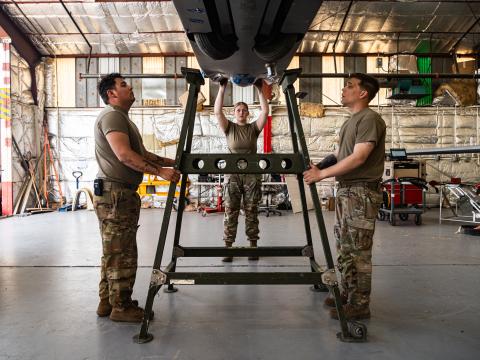Better Birds Bring Broader Capabilities
 |
| This artist rendering illustrates how an Advanced Extremely High Frequency (AEHF) satellite will appear in space. The AEHF satellites are the next phase in the Milstar program. |
Military forces around the world can expect better information sharing beginning next year. The launch of the next generation of satellite communications will bring an order of magnitude jump in communications ability over current capabilities, and the new technology will interact with legacy systems to provide improved services for all users.
The Advanced Extremely High Frequency satellite program, known as AEHF, is on track to launch the first satellite in April 2008, followed by one each year for a total of three satellites purchased by the U.S. Air Force, which is the U.S. Defense Department’s executive agency for space. AEHF is the next step in the military satellite communications (SATCOM) portfolio targeted to provide strategic users with a protected communications system. Advances in this system are expanding its applications to tactical users as well. The AEHF satellite supplies low-jam, low-interference capabilities to troops and top-level decision makers who need to communicate at specific times without interference from jamming or weather. AEHF follows the Milstar satellites already in use by military services and precedes the final step in the series, the Transformational Communications Satellite (TSAT). The TSAT launch dates remain undetermined.
The AEHF satellite system comprises a space vehicle, a payload segment and a ground element mission control system. The vehicle includes the propulsion systems and solar panels; the payload is the actual communications hardware; and the ground segment performs the mission planning and command and control (C2) of the spacecraft.
According to Col. William Harding, USAF, commander of the Protected Satellite Communications Group at Los Angeles Air Force Base and AEHF program manager, the payload and ground element have to come together. A major part of the program is the C2 of the satellites, and program personnel are undertaking various phases of software development for the ground systems. The mission planning element will be distributed to unified commanders to help them plan their communications resource needs.
The satellite program also includes a large terminal segment procured by terminal program offices in the various branches of the military. Personnel in the services are working to update these legacy terminals so they can interface with AEHF, and some new terminals are being created. AEHF is backward compatible with Milstar, and the satellites will cross-link to share messages. The AEHF ground systems must be able to control the satellites, and the satellites must be able to speak to the legacy terminals. The terminals will use the old waveforms of the Milstar program and the new waveforms of the AEHF craft.
Because terminals come in different forms, decisions to upgrade or replace will be made case by case. Fixed-site terminals such as racks on ships likely will be updated. Portable and on-the-move terminals probably will be replaced, especially after extensive use.
The Milstar Block 1 group of satellites provided low-data-rate capabilities. Block 2 enabled medium-data-rate capabilities, and AEHF moves communications one step farther with extended data rates. The TSAT program eventually will incorporate extended data rate plus. Low data rate entails 2.4 kilobits per second, medium data rate is 1.54 megabits per second and extended data rate denotes 8.19 megabits per second. All the data rates are highly protected. The higher data rates give users more capacity, extra coverage and a new flexibility in the planning tool.
Though originally intended as a strategic system, the Milstar program expanded communications to the tactical realm with the advance to medium data rates in Block 2. Col. Harding shares that the U.S. Army started building terminals on the back of high-mobility multipurpose wheeled vehicles then created a manportable version. These advances began channeling the availability of protected communications down to lower tactical levels. Troops on the move could keep in touch at the regimental level without having to stop and set up a line-of-sight antenna to communicate among various units. The introduction of the AEHF capabilities further improves the system. “It basically gives the warfighters a lifeline back to the friendlies,” Col. Harding says.
Under Milstar Block 1, the military had secure voice communications. With the advent of Block 2, troops could send large data files by satellite for the first time. Len Kwiatkowski, vice president and general manager of military space programs for Lockheed Martin Space Systems Company,
With the military placing more reliance on real-time intelligence, the desire for better communications is growing again. “The need for more capacity at higher speeds is what the AEHF is addressing,” Kwiatkowski observes.
 |
| Technicians work in the first AEHF payload, recently delivered to a Lockheed Martin facility in Sunnyvale, California. The payloads contain the satellite’s sensors and other communications devices. |
The satellite employs transmission security devices for frequency hopping over a large band to protect against jamming and interception, and it has encryption so that unauthorized parties cannot decipher traffic. It operates on a 42.5- to 44.5-gigahertz band on which nothing else operates currently. The satellite also has very narrow beams and hops well over the large band, making the beam almost impossible to detect.
As of now, three Milstar satellites are functioning in their correct orbit. Ideally, SATCOM specialists want four geosynchronous communications spacecraft to create a ring around the Earth for the best coverage. The first AEHF satellite will join the Milstar satellites currently in orbit to complete the medium-data-rate ring. Col. Harding explains that because the Air Force has purchased only three AEHF birds, the first TSAT launch will complete the extended-data-rate ring, but he emphasizes that
According to Col. Harding, the transition from Milstar to AEHF will bring an order of magnitude jump in communications capacity, creating more coverage opportunities and more beams and cross-links for users. “That is the big benefit [to troops]—the increased communications,” the colonel states. He adds that another benefit to warfighters is the opportunity for extra networks. The AEHF satellites will bring about a new flexibility for the military in terms of mission planning. Warfighters can fence resources then subfence those same resources to apportion a certain amount, dividing that among users as necessary.
Kwiatkowski believes troops will experience many benefits from the upgrade. “They’re going to enjoy higher speed connections, first of all,” he shares. Warfighters will transmit more data in a shorter period of time. The higher data rates allow troops to be more efficient and to transmit and receive imagery faster and in higher quantities. In addition, the actual coverage on the face of the Earth will be improved. The satellites reduce the burden on the military to manage beams, and features within the payload make AEHF easier to use for communications than Milstar.
The next-generation satellites will improve SATCOM overall. “It’s basically an evolutionary growth … communications services are moving toward an Internet-protocol-based service in space,” Kwiatkowski says. Currently, radio frequency sources are assigned to commanders. A major portion of the software on the ground is associated with planning and managing the actual circuits assigned to users. With the transition, SATCOM will move to a more automated scheme in which multiple users will access the network resource in total, not by specific assignment of frequency. Kwiatkowski notes that over the past 20 years, quality and quantity of services have improved tenfold with each generation of satellite. With AEHF, warfighters will have secure, compatible communications links and will communicate real-time intelligence when they need to, possibly linking to battlefield operations. The satellite evolution is making combat operations more effective and efficient.
The result of the AEHF launches, according to Kwiatkowski, will be improved coverage to disadvantaged users and increases in capacity and coverage. Linkages and coverage are 10 times better with AEHF than with Milstar and will be 10 times greater again with TSAT.
The AEHF satellite has phased array antennas with electronically steerable beams. These antennas allow users to move beams almost instantaneously. Beams can be shared in a specific spot, then they can jump to another site. One beam can service up to four different sites by bouncing electronically. Operators know when the satellites are communicating with them based on time.
The communications spacecraft are geosynchronous, but if necessary, controllers could move the satellites in orbit between different orbital locations. However, such transport takes time, and constellations normally deploy to cover communications requirements. “We don’t move things on a monthly or weekly basis to address emerging requirements,” Col. Harding explains. If a new craft launches or an old one needs replacing, satellites might be reorganized to create a new coverage configuration.
Air Force personnel fly the satellites, assist with the payload and answer questions from field users. Ground problems include talking to the payload and to the craft itself. Communicating with the payload encompasses sending up apportionment orders, and talking to the craft—colloquially referred to as the bus—includes transmitting queries on satellite health and status as well as commands for actions such as propulsion burns to keep the satellite in the correct orbit.
Col. Harding says the program is progressing smoothly and on schedule, though much work remains. Developers have to integrate components, run tests and integrate the satellite with the launch vehicle. Lockheed Martin recently accepted delivery of the payload module from Northrop Grumman Corporation. Personnel at Lockheed Martin will meld the payload with the craft to create the space segment. Lockheed Martin is responsible for the entire system integration of space and ground segments and for ensuring that the satellites interface properly with the terminals. The company builds all the groundstation hardware and software and trains Air Force technicians to fly the satellites. Lockheed Martin also will support the launch. The first AEHF satellite is expected to ride to orbit on an Atlas V 531.
Web Resources
Space and
Lockheed Martin Space Systems Company: www.lockheedmartin.com/ssc
Northrop Grumman: www.northropgrumman.com




Comments